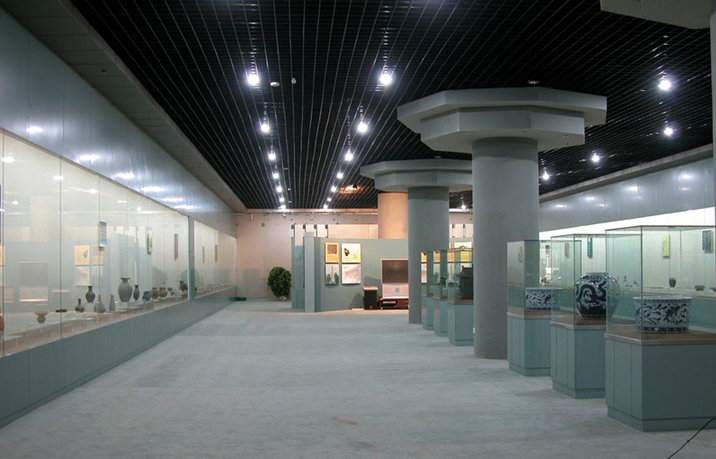Products & Applications
PRODUCTSApplication Scheme
Location Position:Home > Products & ApplicationsApplication of intelligent lighting in museums and exhibition halls

² museum
Museums are exhibition places with certain exhibits as the theme. Under the lighting effect of intelligent lighting control system, various precious objects can be better displayed to visitors, and the artistic beauty and cultural connotation of exhibits can be shown to the world.
As a special exhibition hall displaying various crafts, its space is very different from some large-scale exhibitions. All kinds of exhibits displayed in the exhibition hall are more delicate, so the lighting should pay attention to the expression of details, and the lighting effect is more public display. This kind of exhibition hall is often more demanding on lighting, it needs to rely on the right lighting to create a "correct" lighting environment, to make the exhibits look more attractive. What the audience wants to see is the perfect effect of the exhibits, so the focus light is extremely important and plays the role of creating a visual center. The ambient light cannot be ignored, and these two aspects must work together to create a visual balance. Therefore, we can realize the perfect combination of light and shadow, light and artwork by using intelligent lighting controller. The intelligent control system can not only fully meet the functional requirements, but also prolong the life of the lamps and energy-saving, saving energy for the museum.
1.2 Analysis of project control requirements
According to the control requirements of the museum's lighting system, the overall use of regional control, different floors of public areas and each exhibition hall are relatively independent control areas, the whole system then centralized each area for control and management.
Public area
The public area, especially the hall, is the eye of the building and the first impression of the guests when they enter the museum. The selection of lamps and lighting layout is not only for the needs of lighting, but also for the coordination of lighting atmosphere and architectural decoration. As a high standard national museum should provide visitors with a comfortable and elegant light environment to a greater extent. The lighting in the public area is controlled by the switch, which satisfies the needs of daily application through the opening and closing of the lighting circuit and the control of different scenes. Intelligent touch screen panels are installed at the entrances and exits in public areas to control the opening and closing of a single circuit or multiple circuits, for example, to turn all circuits on and off when entering the touch screen screen screen screen or to turn on and off a circuit separately when entering the circuit screen screen. According to different time and different atmosphere, 0 ~ 6 kinds of lighting scenes can be pre-set, such as morning, noon, afternoon, evening, etc., according to the different collocation of each lighting circuit into a variety of different lighting effects (we call it lighting scene), stored in a scene mode button on the touch screen panel. When the lighting effect needs to be changed, the user can invoke a lighting scene by pressing a button. Such as major festival scenes, daily operation scenes, saving scenes when the audience is small, cleaning scenes and so on.
1) Major festival scene: In major festivals or when important people visit, open this scene, all lights will be turned on, and all lights in the foyer and corridor of the building will be turned on; Highlight the foyer and corridor and other parts, create the overall grand bright lighting atmosphere.
2) Daily operation scenario: In daily operation, the external light is sufficient. Some public areas can make full use of natural light, public areas can choose part of the light back to meet the daily needs, bright without waste. At the same time the lights turn on, can effectively save energy and extend the life of the lamps.
3) Saving scene: It is not necessary to turn on all the lights when the audience is small. Turn on the lights of stairs and corridors and turn off the lights of other parts. It does not affect daily operations and saves energy.
4) Cleaning scene: Turn on a few lights to meet the needs of cleaning work.
In addition to the control of the touch screen panel on the wall, managers or interpreters can also control each circuit or scene of the lighting in each region anytime and anywhere through the tablet computer in their hands while explaining, which not only facilitates the operation of managers but also avoids unnecessary turning on lights, thus saving energy. It also makes the visitors feel the convenience and advancement of intelligent control, thus producing a good impression on the museum.
Exhibition hall
A special exhibition hall, in order to achieve good visual and artistic effects, its lighting energy consumption is very large, lighting energy saving in addition to the selection of lamps, light sources and lighting design should be considered, the rationality of its control system design is the main measure of energy saving. As such exhibition hall displays various objects, the requirements for lighting circuits must be extremely high, and the increase of circuits causes heavy workload such as lighting system management and maintenance. It is necessary to make full use of the characteristics of centralized management of intelligent lighting control system, and combine the management requirements of museums in system design and configuration. It provides technical means for realizing "efficient management" of lighting system. In such an exhibition hall, the light is also the supporting role of the display. It should serve the audience for the works of art or buildings, rather than attract the audience's attention as a master. Therefore, we should give full play to the flexible control function of the intelligent lighting control system and create a "comfortable" visual environment as far as possible. Lighting scenes in the exhibition hall are generally divided into display mode, general mode, end mode and work cleaning mode.
1) Display mode: When exhibits are displayed, general exhibits will be placed in eye-catching glassware. In this state, in order to reflect the details of the exhibits, all display lighting should be turned on to highlight the key parts of the exhibits, while in the corridor area of the exhibition hall, some lighting circuits can be closed accordingly to highlight the exhibits.
2) General mode: In general display, all lights can be combined into a softer scene to slightly highlight the items on display, so that guests can visit and display in a casual environment.
3) End: At the end of the day's exhibition, turn on the surrounding downlights and adjust them to a softer brightness, so that guests can leave the exhibition hall in a comfortable atmosphere.
4) Cleaning: When cleaning, the system only opens a small part of the lighting. To meet the needs of cleaning work while maximizing energy conservation.
In the museum security central control center, through the remote control system can complete the control of the whole museum lighting circuit. You can do everything you can on the panel. All Chinese interface, easier to operate.








